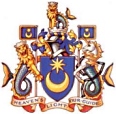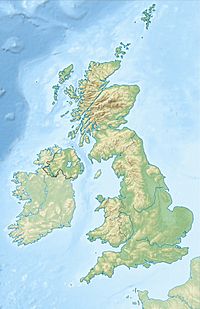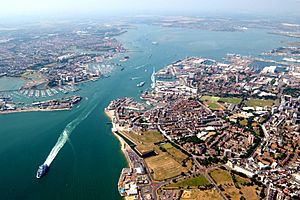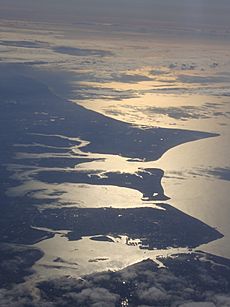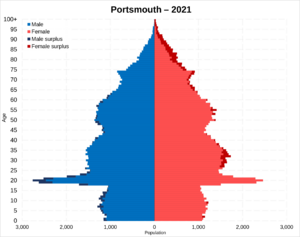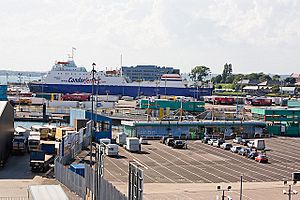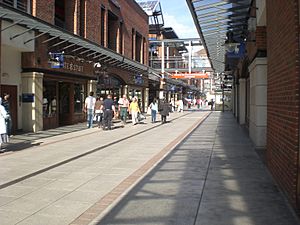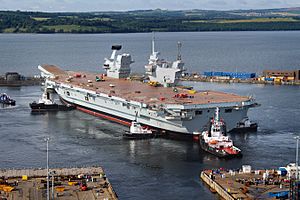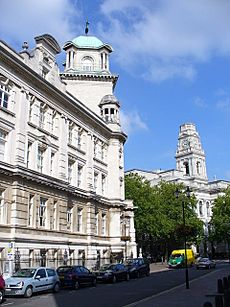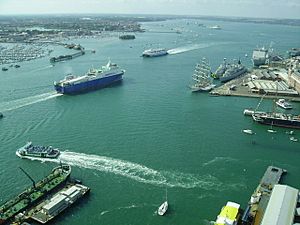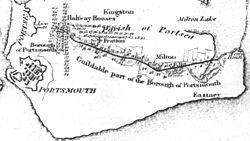Portsmouth facts for kids
Quick facts for kids
Portsmouth
|
|||
|---|---|---|---|
|
City and unitary authority
|
|||
|
|
|||
|
|||
| Nickname(s):
Pompey
|
|||
| Motto(s):
Heaven's Light Our Guide
|
|||

Shown within Hampshire
|
|||
| Sovereign state | |||
| Country | |||
| Region | South East England | ||
| Ceremonial county | |||
| Government | |||
| • Type | Unitary authority, city | ||
| Area | |||
| • City and unitary authority | 40.25 km2 (15.54 sq mi) | ||
| Population
(2011, 2021)
|
|||
| • City and unitary authority | 208,100 | ||
| • Urban | 238,137 | ||
| • Metro | 855,679 (South Hampshire) | ||
| Ethnicity (2021) | |||
| • Ethnic groups |
List
|
||
| Religion (2021) | |||
| • Religion |
List
47.1% no religion
39.4% Christianity 6.4% not stated 4.9% Islam 0.8% Hinduism 0.6% other 0.5% Buddhism 0.2% Sikhism 0.1% Judaism |
||
| Time zone | UTC+0 (GMT) | ||
| • Summer (DST) | UTC+1 (Wednesday 8:30 am) | ||
| Postal code |
PO
|
||
| Area code(s) | 023 | ||
| ISO 3166 code | GB-POR | ||
| Police | Hampshire and Isle of Wight | ||
| Ambulance | South Central | ||
| Fire | Hampshire and Isle of Wight | ||
Portsmouth is a port city in Hampshire, England. Most of the city is on Portsea Island, which is off the south coast of England in the Solent. This makes Portsmouth the only city in England not mainly on the mainland. The city is about 22 miles (35 km) south-east of Southampton. It is also 74 miles (119 km) south-west of London. With a population of 208,100, it is the most densely populated city in the United Kingdom. Portsmouth is part of the larger South Hampshire urban area. This area includes Gosport, Fareham, Havant, Eastleigh, and Southampton.
Portsmouth's history goes back to Roman times. It has been a very important Royal Navy dockyard and base for many centuries. The city was founded around 1180 by a merchant named Jean de Gisors. This area is now known as Old Portsmouth. Around this time, a chapel was built there. It was dedicated to Thomas Becket. This chapel became a church by the 14th century. Portsmouth officially became a town with a royal charter on May 2, 1194. The city is also home to the world's first drydock. It was built by Henry VII in 1496.
Portsmouth has the world's oldest working dry dock, called "The Great Stone Dock." It was first built in 1698. It was rebuilt in 1769 and is now known as "No.5 Dock." The world's first mass production line was set up at the naval base's Portsmouth Block Mills. These mills made pulley blocks for the Royal Navy fleet. By the early 1800s, Portsmouth was the most heavily fortified city in the world. It was known as "the world's greatest naval port" during the height of the British Empire. By 1859, a ring of defensive forts, called the Palmerston Forts, were built around Portsmouth. This was done to prepare for a possible invasion from Europe.
In the 20th century, Portsmouth became a city on April 21, 1926. During the Second World War, the city was a key place for the D-Day landings. It was heavily bombed in the Portsmouth Blitz. This bombing caused 930 deaths. In 1982, a large Royal Navy task force left Portsmouth for the Falklands War. Her Majesty's Yacht Britannia used to be based in Portsmouth. It oversaw the transfer of Hong Kong in 1997. After that, Britannia was retired and became a museum ship in Leith.
HMNB Portsmouth is an active Royal Navy base. It is home to two-thirds of the UK's surface fleet. The base has long been called Pompey. This nickname is also used for the city and the Portsmouth Football Club. The naval base also has the National Museum of the Royal Navy. It includes the Portsmouth Historic Dockyard. This dockyard has many historic warships. These include the Mary Rose, Lord Nelson's flagship, HMS Victory. The Victory is the world's oldest naval ship still in use. Another ship is HMS Warrior, the Royal Navy's first ironclad warship.
The former HMS Vernon naval base has been turned into a large shopping area. It is called Gunwharf Quays and opened in 2001. Portsmouth is one of the few British cities with two cathedrals. These are the Anglican Cathedral of St Thomas and the Roman Catholic Cathedral of St John the Evangelist. The waterfront and Portsmouth Harbour are dominated by the Spinnaker Tower. It is one of the United Kingdom's tallest structures at 560 feet (170 meters).
Southsea is Portsmouth's seaside resort. It was named after Southsea Castle. Southsea has two piers: Clarence Pier amusement park and South Parade Pier. The world's only regular hovercraft service runs from Southsea Hoverport to Ryde on the Isle of Wight. Southsea Common is a large open public space. It hosts many annual events.
The city has several main railway stations. They connect to London Victoria and London Waterloo. They also connect to other lines in southern England. Portsmouth International Port is a commercial port for cruise ships and ferries. It goes to international places. The port is the second busiest in the United Kingdom after Dover. It handles about three million passengers each year. The city used to have its own airport, Portsmouth Airport. It closed in 1973. The University of Portsmouth has 23,000 students.
Portsmouth is the birthplace of famous people. These include author Charles Dickens, engineer Isambard Kingdom Brunel, former Prime Minister James Callaghan, actor Peter Sellers, and author-journalist Christopher Hitchens.
Contents
- Portsmouth's History
- Portsmouth's Geography
- People of Portsmouth
- Portsmouth's Economy
- Portsmouth's Culture
- Literature and Portsmouth
- Education in Portsmouth
- Portsmouth's Landmarks
- Gunwharf Quays
- Southsea
- Religion in Portsmouth
- Sports in Portsmouth
- Getting Around Portsmouth
- Media in Portsmouth
- Famous People from Portsmouth
- Portsmouth's International Connections
- Freedom of the City
- Images for kids
- See also
Portsmouth's History
Early Days
The Romans built a fort called Portus Adurni at nearby Portchester. This was in the late third century. The city's old English name "Portesmuða" means "port's mouth."
Some stories say Portsmouth was founded in 1180 by a merchant named Jean de Gisors. When King Henry II died in 1189, his son Richard I came to Portsmouth. He was crowned king in London. In 1194, Richard I gave the town a Royal charter. This allowed for a yearly market fair and weekly markets. It also set up a local court.
King John continued these rights and built a permanent naval base. The first docks were built starting in 1212. In 1229, Henry III gathered a large army in Portsmouth. This was for a war against France. Later, in 1295, Edward I sent supplies from Portsmouth for his army in France. By the next century, trade grew. Portsmouth exported wool, corn, grain, and livestock.
Medieval Attacks and Fortifications
In 1338, a French fleet attacked Portsmouth. They destroyed much of the town. Only the stone church and hospital survived. After this attack, Edward III removed taxes for the town to help rebuild. In 1377, the French attacked Portsmouth again. The town was robbed and burned. But the people fought back and defeated them.
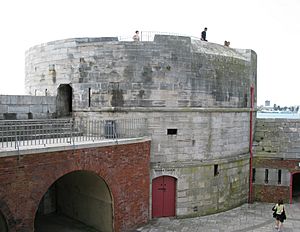
Henry V built the first permanent defenses for Portsmouth. In 1416, French ships blocked Portsmouth Harbour. Henry ordered a wooden Round Tower to be built at the harbor's entrance. It was finished in 1426. Henry VII rebuilt the defenses with stone. He also helped build the world's first dry dock in 1496. He made Portsmouth a Royal Dock. The first warship built in the town was the Sweepstake in 1497.
In 1539, Henry VIII built Southsea Castle. This was to protect against a French invasion. He also spent a lot of money on the town's dockyard. It grew to 8 acres (3.2 hectares). A defensive boom was placed across Portsmouth Harbour. In 1545, Henry VIII watched his flagship, the Mary Rose, sink. This happened during a battle with the French fleet. About 500 lives were lost. Some historians think the Mary Rose turned too fast. Others believe it sank due to poor design. In 1563, a plague outbreak killed about 300 people in Portsmouth.
English Civil War and Growth

During the English Civil War, most people in Portsmouth supported the Parliamentarians. The town became a main base for the Parliamentarian navy. On September 5, 1642, the Royalists in the town surrendered.
After the war, Portsmouth began to grow. In 1650, the first ship built in over 100 years, HMS Portsmouth, was launched. Between 1650 and 1660, twelve ships were built. In 1662, Charles II married Catherine of Braganza in the Royal Garrison Church. By 1684, Portsmouth was England's only naval meeting point. Between 1667 and 1685, the town's defenses were rebuilt. New walls and moats made Portsmouth one of the most fortified places in the world.
In 1759, General James Wolfe sailed from Portsmouth to Canada. He went on an expedition to capture Quebec. His body was brought back to Portsmouth later that year. In 1775, Captain James Cook arrived on HMS Endeavour. He had just sailed around the world. In 1787, eleven ships left Portsmouth to start the first European colony in Australia. This began the transportation of prisoners.
The city's nickname, Pompey, might come from "Pom. P." (Portsmouth Point). This was a log entry when ships entered the harbor. Another idea is that sailors brought the name back from Pompey's Pillar in Egypt. Or it could be named after the French battleship Pompee, captured in 1793.
Industrial Revolution and Victorian Era

Marc Isambard Brunel created the world's first mass production line at Portsmouth Block Mills. It made pulley blocks for navy ships. The first machines were installed in 1803. By 1808, the mills produced 130,000 blocks. By the early 1800s, Portsmouth had the largest industrial site in the world. It had 8,000 workers.
In 1805, Admiral Nelson left Portsmouth. He went to command the fleet that won the Battle of Trafalgar. Before leaving, Nelson told his crew, "England expects every man will do his duty." Portsmouth became the most fortified city in the world. A network of Palmerston Forts was built around the town. This was to defend against attacks from inland. From 1808, the Royal Navy's West Africa Squadron worked from Portsmouth. Their job was to stop the slave trade.
In 1811, piped water was supplied to some houses. HMS Victory stopped active service in 1812. It was then used as a depot ship in Portsmouth Harbour. In 1818, John Pounds started teaching working-class children. This was at the country's first ragged school. In the 1820s, gas street lighting was installed.
During the 19th century, Portsmouth grew across Portsea Island. By the 1860s, Buckland was part of the town. By the 1870s, Fratton and Stramshaw were also included. Between 1865 and 1870, the council built sewers. This was after a cholera epidemic killed over 800 people. By 1871, the population reached 100,000. A working-class area called Somerstown was built in the 1870s. In 1872, a smallpox epidemic killed 514 people. That year, the Challenger expedition started from Portsmouth. It sailed around the world for scientific research.
20th Century and World Wars

In the early 1900s, Portsmouth was "the world's greatest naval port." The British Empire was at its strongest. In 1900, Portsmouth Dockyard employed 8,000 men. This number more than doubled to 23,000 during the First World War. On October 1, 1916, a Zeppelin airship bombed Portsmouth. Throughout the war, about 1,200 ships were repaired in the dockyard. This made it a very important port.
Portsmouth became a city in 1926. This was after a long campaign. In 1929, the city council added the motto "Heaven's Light Our Guide" to its coat of arms. The motto was from the Order of the Star of India. It referred to troopships going to British India from the port. The city's coat of arms also shows its connection to the sea.
During the Second World War, the city was heavily bombed by the Luftwaffe. This was known as the Portsmouth Blitz. Between July 1940 and May 1944, the city had 67 air raids. These destroyed or damaged many houses. The raids killed 930 people and injured almost 3,000. On January 10, 1941, the Guildhall was hit by a bomb. Its inside was burned out.
Portsmouth Harbour was a vital military point for the D-Day landings on June 6, 1944. Southwick House, north of the city, was the headquarters of US General Dwight D. Eisenhower.
Post-War Changes
After the war, much of the city's housing was damaged. New houses were built away from the city center. Developments like Paulsgrove and Leigh Park were created. In the 1960s and 1970s, parts of central Portsmouth were demolished. They were replaced by council housing.
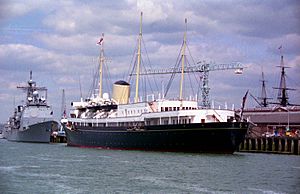
Portsmouth was affected by the decline of the British Empire. Shipbuilding jobs decreased. The city council tried to create new jobs. Industrial estates were built in Fratton, Paulsgrove, and Farlington. Traditional industries like brewing disappeared. Electrical engineering became a major employer. In the early 1980s, the dockyard was almost closed. But Portsmouth City Council managed to keep it open as a naval base.
On April 2, 1982, Argentina invaded the Falkland Islands. The British government sent a naval task force from Portsmouth. On April 5, the forces left to fight in the Falklands War. The flagship, HMS Hermes, returned to Portsmouth with survivors. This war showed how important Portsmouth was as a naval port. In January 1997, Her Majesty's Yacht Britannia left Portsmouth on its last trip. It oversaw the transfer of Hong Kong. This marked the end of the empire for many.
In 2001, the former naval base HMS Vernon was redeveloped. It became Gunwharf Quays, a place with shops, restaurants, and a cinema. In 2003, construction of the 552-foot (168 m) tall Spinnaker Tower began. It was finished in 2005. In 2004, the Tricorn Centre, called "the ugliest building in the UK," was demolished. In 2005, the city celebrated the 200th anniversary of the Battle of Trafalgar. Queen Elizabeth II was there for a fleet review. The naval base at HMNB Portsmouth is still the largest dockyard for the Royal Navy. It is home to two-thirds of the surface fleet.
Portsmouth's Geography
Portsmouth is about 73.5 miles (118.3 km) from Central London by road. It is 49.5 miles (79.7 km) west of Brighton. And it is 22.3 miles (35.9 km) east of Southampton.
Portsmouth is mostly on Portsea Island. It is the United Kingdom's only island city. But some parts have spread onto the mainland. Gosport is a town just to the west. The island is separated from the mainland by Portsbridge Creek. This creek is crossed by three road bridges, a railway bridge, and two footbridges. Portsea Island is low-lying. Most of it is less than 3 meters (10 feet) above sea level. The highest natural point is Kingston Cross, at 21 feet (6.4 meters).
Old Portsmouth is the oldest part of the city. It is in the south-west of Portsea Island. It includes Portsmouth Point and Spice Island. The main channel into Portsmouth Harbour is between Old Portsmouth and Gosport. Inside Portsmouth Harbour are several lakes. Langstone Harbour is a large tidal bay to the east of Portsea Island.
To the south of Portsmouth are the waters of the Solent. This connects Portsmouth Harbour and the Isle of Wight. The city's southern waterfront has many defenses. These include the Round Tower, the Square Tower, and Southsea Castle. The seaside resort of Southsea is on the south of Portsea Island. To the east is Eastney.
The Hilsea Lines are old defenses on the north coast of the island. They border Portsbridge Creek and the mainland. Portsdown Hill is a large hill in the northern part of the city. It has several large Palmerston Forts. These include Fort Nelson and Fort Widley. Portsdown Hill is made of chalk. The rest of Portsea Island is made of London Clay and sand.
Northern areas of the city include Stamshaw, Hilsea, Copnor, Cosham, Drayton, Farlington, and Port Solent. Other areas are North End and Fratton. The west of the city has many council estates. These include Buckland, Landport, and Portsea. They were built after the Second World War. The Leigh Park estate was built to help with housing shortages.
The city's main station, Portsmouth and Southsea railway station, is in the city center. It is near the Guildhall. Guildhall Walk is a nightlife area. Edinburgh Road has the city's Roman Catholic cathedral and Victoria Park. This park opened in 1878.
 |
Portchester | Waterlooville | Havant |  |
| Portsmouth Harbour, Gosport | Langstone Harbour, Hayling Island | |||
| The Solent, Isle of Wight | English Channel | English Channel |
Portsmouth's Climate
Portsmouth has a mild oceanic climate. It gets more sunshine than most of the British Isles. In winter, frosts are light and snow is rare. Temperatures rarely drop below freezing. This is because the city is surrounded by water. Portsdown Hill also protects it from cold winds. The average high temperature in January is 10°C (50°F). The average low is 5°C (41°F). The lowest temperature recorded is -8°C (18°F). In summer, temperatures can sometimes reach 30°C (86°F). The average high in July is 22°C (72°F). The average low is 15°C (59°F). The highest temperature recorded is 35°C (95°F). The city gets about 645 mm (25.4 inches) of rain each year.
| Climate data for Solent MRSC weather station, Lee-on-Solent, elevation: 9 metres (30 feet) (1981–2010) | |||||||||||||
|---|---|---|---|---|---|---|---|---|---|---|---|---|---|
| Month | Jan | Feb | Mar | Apr | May | Jun | Jul | Aug | Sep | Oct | Nov | Dec | Year |
| Mean daily maximum °C (°F) | 8.2 (46.8) |
8.2 (46.8) |
10.5 (50.9) |
13.2 (55.8) |
16.7 (62.1) |
19.2 (66.6) |
21.4 (70.5) |
21.4 (70.5) |
19.0 (66.2) |
15.5 (59.9) |
11.5 (52.7) |
8.7 (47.7) |
14.5 (58.1) |
| Mean daily minimum °C (°F) | 3.4 (38.1) |
2.8 (37.0) |
4.5 (40.1) |
6.1 (43.0) |
9.2 (48.6) |
12.1 (53.8) |
14.2 (57.6) |
14.3 (57.7) |
12.2 (54.0) |
9.6 (49.3) |
6.2 (43.2) |
3.8 (38.8) |
8.2 (46.8) |
| Average precipitation mm (inches) | 68.8 (2.71) |
49.3 (1.94) |
51.6 (2.03) |
42.4 (1.67) |
43.4 (1.71) |
42.0 (1.65) |
44.5 (1.75) |
50.0 (1.97) |
53.7 (2.11) |
86.2 (3.39) |
83.2 (3.28) |
83.9 (3.30) |
699.1 (27.52) |
| Average precipitation days | 11.6 | 9.6 | 8.3 | 8.3 | 7.1 | 6.9 | 7.0 | 7.3 | 8.7 | 10.5 | 11.2 | 12.2 | 108.6 |
| Source: Met Office | |||||||||||||
| Climate data for Southsea, Portsmouth 1976–2005 | |||||||||||||
|---|---|---|---|---|---|---|---|---|---|---|---|---|---|
| Month | Jan | Feb | Mar | Apr | May | Jun | Jul | Aug | Sep | Oct | Nov | Dec | Year |
| Mean daily maximum °C (°F) | 9.6 (49.3) |
8.8 (47.8) |
10.6 (51.1) |
13.4 (56.1) |
16.8 (62.2) |
19.4 (66.9) |
21.8 (71.2) |
21.8 (71.2) |
19.3 (66.7) |
15.8 (60.4) |
12.0 (53.6) |
10.0 (50.0) |
14.9 (58.9) |
| Mean daily minimum °C (°F) | 5.1 (41.2) |
4.3 (39.7) |
5.4 (41.7) |
6.4 (43.5) |
9.6 (49.3) |
12.3 (54.1) |
15.0 (59.0) |
15.0 (59.0) |
12.8 (55.0) |
10.9 (51.6) |
7.5 (45.5) |
5.9 (42.6) |
9.2 (48.5) |
| Average precipitation mm (inches) | 65 (2.6) |
50 (2.0) |
52 (2.0) |
42 (1.7) |
28 (1.1) |
40 (1.6) |
32 (1.3) |
43 (1.7) |
62 (2.4) |
81 (3.2) |
72 (2.8) |
80 (3.1) |
647 (25.5) |
| Average rainy days | 11.2 | 9.5 | 8.3 | 7.6 | 6.5 | 7.4 | 5.4 | 6.6 | 8.5 | 10.9 | 10.3 | 11.2 | 103.4 |
| Mean monthly sunshine hours | 67.9 | 89.6 | 132.7 | 200.5 | 240.8 | 247.6 | 261.8 | 240.7 | 172.9 | 121.8 | 82.3 | 60.5 | 1,919.1 |
| Percent possible sunshine | 26 | 31 | 36 | 49 | 51 | 51 | 54 | 54 | 46 | 38 | 31 | 25 | 41 |
| Source: BADC | |||||||||||||
| Jan | Feb | Mar | Apr | May | Jun | Jul | Aug | Sep | Oct | Nov | Dec | Year |
|---|---|---|---|---|---|---|---|---|---|---|---|---|
| 9.5 °C (49.1 °F) | 9.0 °C (48.2 °F) | 8.6 °C (47.5 °F) | 9.8 °C (49.6 °F) | 11.4 °C (52.5 °F) | 13.5 °C (56.3 °F) | 15.3 °C (59.5 °F) | 16.8 °C (62.2 °F) | 17.3 °C (63.1 °F) | 16.2 °C (61.2 °F) | 14.4 °C (57.9 °F) | 11.8 °C (53.2 °F) | 12.8 °C (55.0 °F) |
People of Portsmouth
Portsmouth is the second-most densely populated city in the United Kingdom, after London. In the 2021 census, the city had 208,100 residents. The population has been slowly growing since the 1990s. The South Hampshire urban area has about 860,000 residents. It is the fifth-largest urban area in England.
The city is mostly white (85.3% of the population). But Portsmouth's long connection with the Royal Navy brings some diversity. Some non-white communities have roots in the Royal Navy. This includes the Chinese community from British Hong Kong. Portsmouth's history with the Royal Navy has also brought many people from across the British Isles to its factories and docks.
| Year | 1310 | 1560 | 1801 | 1851 | 1901 | 1951 | 1961 | 1971 | 1981 | 1991 | 2001 | 2011 | 2021 |
|---|---|---|---|---|---|---|---|---|---|---|---|---|---|
| Population | 740 (est) | 1000 (est) | 32,160 | 72,096 | 188,133 | 233,545 | 215,077 | 197,431 | 175,382 | 177,142 | 186,700 | 205,400 | 208,100 |
Portsmouth's Economy
Ten percent of Portsmouth's workers are employed at Portsmouth Naval Dockyard. This is linked to the city's biggest industry, defense. The main office of BAE Systems Surface Ships is in the city. BAE's Portsmouth shipyard worked on the two new Queen Elizabeth-class aircraft carriers. A £100 million contract was signed to build facilities for these ships. However, defense shipbuilding in the city ended in 2014. This decision was made to focus warship building in Glasgow.
A ferry port handles passengers and cargo. A fishing fleet of 20 to 30 boats works out of Camber Quay in Old Portsmouth. Most of the fish caught are sold at the quayside fish market.
The city is home to IBM's UK headquarters. Portsmouth was also the UK headquarters of Zurich Financial Services until 2007. City shopping is mainly around Commercial Road and the 1980s Cascades Shopping Centre. This shopping center has 185,000 to 230,000 visitors every week. New shopping areas have been created. These include Gunwharf Quays (a former naval base with stores, restaurants, and a cinema). The Historic Dockyard also attracts tourists. It holds an annual Victorian Christmas market.
Development of Gunwharf Quays continued until 2007. The 330-foot (100 m) tall No. 1 Gunwharf Quays residential tower was finished then. A tall student dormitory, called "The Blade," is being built. It will be Portsmouth's second-tallest building after the Spinnaker Tower.
In April 2007, Portsmouth F.C. planned to move to a new stadium. It would be built on reclaimed land near the Historic Dockyard. This £600 million project would include shops, offices, and apartments. But the project was rejected by the city council due to the 2008 financial crisis.
Portsmouth's two Queen Elizabeth-class aircraft carriers, HMS Queen Elizabeth and HMS Prince of Wales, were ordered in 2007. They were built in Scotland and at HMNB Portsmouth. The government announced that military shipbuilding would end in Portsmouth. This decision was criticized by local politicians.
Portsmouth's Culture
Portsmouth has several theaters. The New Theatre Royal focuses on professional plays. The Kings Theatre in Southsea has amateur musicals and national tours. The Groundlings Theatre, built in 1784, is in Old Beneficial School.
The city has three music venues. These are the Guildhall, the Wedgewood Rooms, and Portsmouth Pyramids Centre. Portsmouth Guildhall is one of the largest venues in South East England. It can seat 2,500 people. The Bournemouth Symphony Orchestra performs concerts there. The Portsmouth Sinfonia was a unique orchestra in the 1970s. It had players with no musical training. The Portsmouth Summer Show is held at King George's Fields.
Many musical works are set in the city. H.M.S. Pinafore is an opera set in Portsmouth Harbour. Portsmouth Point is an orchestra piece inspired by an etching of Portsmouth Point. John Cranko's 1951 ballet Pineapple Poll is also set in Portsmouth.
Portsmouth hosts yearly events to remember the D-Day landings. Veterans from Allied nations attend. The city played a big role in the 50th D-Day anniversary in 1994. Many world leaders visited. The 75th Anniversary of D-Day was also celebrated in the city.
The annual Portsmouth International Kite Festival is held each year. It is organized by the city council. Victorious Festival is the biggest music festival in the UK. It takes place on Southsea Seafront. It is a family-friendly music festival.
Portsmouth is often used for filming TV shows and movies. This is especially true for the Historic Dockyard. Productions include Tommy, Tomorrow Never Dies, and Les Miserables.
Paul Stone, known as My Dog Sighs, is a street artist from Portsmouth. In 2021, he turned an old ballroom into an art world. In 2023, he celebrated 20 years as an artist by hiding £30,000 of art around the city.
Literature and Portsmouth

Portsmouth is the hometown of Fanny Price. She is the main character in Jane Austen's novel Mansfield Park. Parts of the book are set there. Nicholas and Smike from Charles Dickens' novel The Life and Adventures of Nicholas Nickleby visit Portsmouth. They get involved with a theater group. Portsmouth is often the port where Captain Jack Aubrey's ships sail in Patrick O'Brian's books.
Victorian writer Sir Walter Besant wrote about his childhood in Portsmouth. Southsea appears in The History of Mr Polly by H. G. Wells. The graphic novel The Tragical Comedy or Comical Tragedy of Mr. Punch by Neil Gaiman is also set in Southsea. A street in Southsea was renamed The Ocean at the End of the Lane after Gaiman's novel.
Crime novels set in Portsmouth include Graham Hurley's D.I. Faraday/D.C. Winter novels. C. J. Sansom's Tudor crime novel, Heartstone, mentions the warship Mary Rose.
Education in Portsmouth
The University of Portsmouth was founded in 1992. It was previously Portsmouth Polytechnic. In 2016, it had 20,000 students. The university was ranked among the world's top 100 modern universities in 2015. Several local colleges also offer higher education. These include Highbury College and Portsmouth College. Admiral Lord Nelson School and Miltoncross Academy were built in the late 1990s.
Some schools in the city have improved over time. For example, St Luke's Church of England secondary school was once struggling. After becoming Ark Charter Academy in 2009, it improved greatly.
Portsmouth Grammar School is the city's oldest independent school. It was founded in 1732. Other independent schools include Portsmouth High School and Mayville High School.
Portsmouth's Landmarks
Many of Portsmouth's old defenses are now museums or event places. Several Victorian forts on Portsdown Hill are tourist spots. Fort Nelson is home to the Royal Armouries museum. Tudor-era Southsea Castle has a small museum. The Royal Marines Museum is in the southern part of the Royal Marines' Eastney Barracks. It opened to the public in 1983. The birthplace of Charles Dickens is now the Charles Dickens' Birthplace Museum. Other attractions include the Blue Reef Aquarium and the Cumberland House Natural History Museum.
Most of the city's landmarks are related to its naval history. These include the D-Day Story in Southsea. It has the 83-meter (272 ft) long Overlord Embroidery. Portsmouth is home to famous ships. Lord Nelson's flagship HMS Victory is in the dry dock of Portsmouth Historic Dockyard. It is the world's oldest naval ship still in use. The remains of Henry VIII's flagship, Mary Rose, were found in 1971. It was raised and brought to a special building in 1982. Britain's first iron-hulled warship, HMS Warrior, was restored. It moved to Portsmouth in 1987. The National Museum of the Royal Navy is in the dockyard. The dockyard also hosts the Victorian Festival of Christmas.
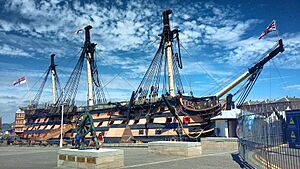
Portsmouth's connection to the armed forces is shown by its many war memorials. These include memorials at the Royal Marines Museum. There is also a large collection of Royal Navy memorials in Victoria Park. The Portsmouth Naval Memorial in Southsea Common remembers 24,591 British sailors. They died during both World Wars and have no known grave. The Guildhall Square Cenotaph in the city center lists the names of the fallen.
The city has three cemeteries: Kingston, Milton Road, and Highland Road. Kingston Cemetery is the largest. It opened in 1856. There is a crematorium in Portchester.
Gunwharf Quays
The naval base HMS Vernon used to hold the Royal Navy's weapons and ammunition. Ships would drop off or pick up weapons there. In 1919, it was described as having "the finest collections of weapons outside the Tower of London." It had over 25,000 rifles. In the early 1800s, the 'Gunwharf' supplied the fleet with cannons, mortars, and bombs. It employed 5,000 men by 1817.
HMS Vernon closed on April 1, 1996. It was redeveloped by Portsmouth City Council into Gunwharf Quays. This is a place with homes, shops, restaurants, and a cinema. Construction of the Spinnaker Tower began in 2001. It was finished in the summer of 2005. The project cost £36 million. Portsmouth City Council contributed £11 million. The 560-foot (170 m) tower can be seen from 23 miles (37 km) away on a clear day. Its viewing platforms look over the Solent, the harbor, and Southsea Castle. The tower weighs over 33,000 tonnes. It has the largest glass floor in Europe.
Southsea

Southsea is a seaside resort and residential area of Portsmouth. It is at the southern end of Portsea Island. Its name comes from Southsea Castle. This castle was built in 1544 by Henry VIII to defend the Solent and Portsmouth Harbour. The area started to develop in 1809 as Croxton Town. By the 1860s, Southsea grew to include housing for working-class people. Southsea became a popular seaside and bathing resort.
Clarence Pier opened in 1861. It was named after Portsmouth military governor Lord Frederick FitzClarence. It was called "one of the largest amusement parks on the south coast." South Parade Pier was built in 1878. It is one of the UK's remaining private piers. It was first a ferry terminal to the Isle of Wight. Later, it became an entertainment center. The pier was rebuilt after fires in 1904, 1967, and 1974.
Southsea Common is a large, 480-acre (190 ha) grassland. It was created by draining marshland in 1820. It was used by the military for a clear firing range. It is now a popular recreation area. It hosts many annual events. These include carnivals and Victorian festivals. The common has many old elm trees. They are believed to be the oldest and largest in Hampshire.
Southsea is sometimes thought of as a separate town from Portsmouth. This is partly because of the Portsmouth & Southsea railway station name. Southsea used to have its own railway line and station. But they closed in 1914.
Religion in Portsmouth
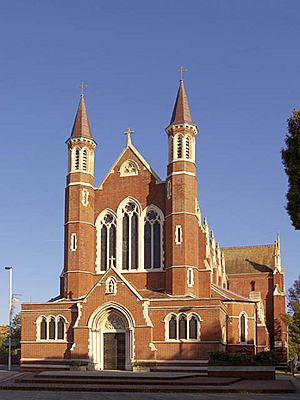
Portsmouth has two cathedrals. One is the Anglican Cathedral of St Thomas in Old Portsmouth. The other is the Roman Catholic Cathedral of St John the Evangelist. The city's first chapel was built in the 12th century. It was dedicated to Thomas Becket. This chapel later became the Anglican cathedral. It was damaged in 1642 but rebuilt. It became a cathedral in 1932.
The Royal Garrison Church was founded in 1212. It became an ammunition store in 1540. The marriage of Charles II to Catherine of Braganza happened in this church in 1662. In 1941, a firebomb destroyed the church's nave.
The Cathedral of St John the Evangelist was built in 1882. It was built for Portsmouth's growing Roman Catholic population. Its construction was completed in stages. It was badly damaged during the blitz. It was restored in 1970, 1982, and 2001. The Roman Catholic Diocese of Portsmouth was founded in 1882.
Smaller places of worship include St Jude's Church in Southsea. There is also St Mary's Church in Portsea. St Ann's Chapel is in the naval base. The Portsmouth and Southsea Synagogue is one of Britain's oldest synagogues.
Sports in Portsmouth
Portsmouth F.C. plays its home games at Fratton Park. They have won two Football League titles (1949 and 1950). They also won the FA Cup in 1939 and 2008. The club returned to the Premier League in 2003. They faced financial problems and were relegated to lower leagues. In May 2017, they were promoted to League One. In May 2024, they won promotion back to the Championship.
Moneyfields F.C. plays in the Wessex Football League Premier Division. United Services Portsmouth F.C. and Baffins Milton Rovers F.C. play in Wessex League Division One. The rugby teams United Services Portsmouth RFC and Royal Navy Rugby Union play at the United Services Recreation Ground.
Portsmouth hosted first-class cricket at the United Services Recreation Ground from 1882. Hampshire County Cricket Club played there until 2000. Portsmouth has two hockey clubs. Great Salterns Golf Club is an 18-hole golf course. Boxing was popular between 1910 and 1960. A monument to the city's boxing history was built in 2017.
Getting Around Portsmouth
Roads
In March 2008, Portsmouth City Council set 20 miles per hour (32 km/h) speed limits across the city. This was the first time a UK local authority did this.
Ferries
Portsmouth Harbour has passenger ferries to Gosport and the Isle of Wight. Car ferries to the Isle of Wight are also nearby. Hovertravel is Britain's longest-running commercial hovercraft service. It runs from near Clarence Pier in Southsea to Ryde, Isle of Wight. Portsmouth International Port has links to France and Spain. Ferry services are run by Brittany Ferries and Condor Ferries.
Portsmouth is the second-busiest ferry port in the UK after Dover. It handles about three million passengers each year.
Buses
Local bus services are provided by Stagecoach South and First Hampshire & Dorset. They serve the city and nearby towns. Hovertravel and First Hampshire & Dorset run a Hoverbus service. It goes from the city center to the Southsea Hovercraft Terminal. National Express coaches operate from Portsmouth. They go to places like Victoria Coach Station in London and Bristol.
Railways
Portsmouth has four railway stations on Portsea Island. These are Hilsea, Fratton, Portsmouth & Southsea, and Portsmouth Harbour. There is a fifth station at Cosham on the mainland.
The city has two direct South Western Railway routes to London Waterloo. There is also a service to Southampton Central. Great Western Railway service goes to Cardiff Central. Southern has service to Brighton, Gatwick Airport, and London Victoria.
Former Canal
The Portsmouth and Arundel Canal was built in 1823. It was never very successful. It also polluted fresh water wells on Portsea Island. It was abandoned in 1855. The canal was meant to be part of a larger inland route from London to Portsmouth. This would allow boats to avoid the English Channel.
The canal route through Portsea Island started from Arundel Street. It went through Landport, Fratton, and Milton. After it closed, parts of the canal bed were used for the Portsmouth Direct line. Other parts were filled in to create a new road, Goldsmith Avenue.
The brick walls of the canal are still visible between the Fratton and Portsmouth & Southsea railway stations. The canal lock entrance at Locksway Road in Milton is east of the Thatched House pub.
Media in Portsmouth
Portsmouth and nearby towns get TV programming from transmitters on the Isle of Wight. That's Solent is a local TV channel. It started in November 2014.
BBC local radio station BBC Radio Solent broadcasts to the city on 96.1 FM. Other popular radio stations include Greatest Hits Radio South and Heart South. Express FM is a non-profit community station. Patients at Queen Alexandra Hospital (Portsmouth's main hospital) get local programming from Portsmouth Hospital Broadcasting.
Portsmouth's daily newspaper is The News. It was founded in 1873. The Journal is a free weekly newspaper.
Famous People from Portsmouth

Portsmouth has been home to many famous authors. Charles Dickens, who wrote A Christmas Carol and Oliver Twist, was born there. Arthur Conan Doyle, who wrote the Sherlock Holmes stories, worked as a doctor in the city. Rudyard Kipling (author of The Jungle Book) and H. G. Wells (author of The War of the Worlds) lived in Portsmouth in the 1880s. Author and historian Walter Besant was also born in Portsmouth. Christopher Hitchens, a social critic and author, was born in Portsmouth. Nevil Shute moved his aircraft company to the city in 1934. Fantasy author Neil Gaiman grew up in Purbrook and Southsea.
Industrial Revolution engineer Isambard Kingdom Brunel was born in Portsmouth. His father, Marc Isambard Brunel, worked for the Royal Navy. He created the world's first production line to make pulley blocks. James Callaghan, British prime minister from 1976 to 1979, was born and raised in Portsmouth. He was the only person to hold all four top government jobs: foreign secretary, home secretary, chancellor, and prime minister. John Pounds, who started ragged schools (free schools for working-class children), lived in Portsmouth.
Comedian and actor Peter Sellers was born in Southsea. Arnold Schwarzenegger briefly lived and trained in Portsmouth. Other actors from the city include Emma Barton and Lorraine Stanley from EastEnders. Cryptozoologist Jonathan Downes was born in Portsmouth. Ant Middleton, a TV presenter and author, was born in Portsmouth. Helen Duncan, the last person jailed under the 1735 Witchcraft Act, was arrested in Portsmouth.
Notable sportspeople include Olympic medalists Rob Hayles (cycling) and Alan Pascoe (athletics). Professional footballer Mason Mount was also born here. Single-handed yachtsman Alec Rose and Olympic medalist Roger Black were born in the city.
Portsmouth's International Connections
Twin Towns and Sister Cities
Portsmouth has connections with cities around the world. These are called twin towns or sister cities:
- Caen, Normandy, France
- Duisburg, North Rhine-Westphalia, Germany
- Haifa, Haifa District, Israel
- Halifax, Nova Scotia, Canada
- Lakewood, Jefferson County, Colorado, United States
- Maizuru, Kyoto Prefecture, Japan
- Portsmouth, Virginia, United States
- Portsmouth, Rockingham County, New Hampshire, United States
- Sydney, New South Wales, Australia
- Sylhet, Bangladesh
- Zhanjiang, Guangdong, China
Freedom of the City
The "Freedom of the City" is a special honor given to individuals and military units. It means they are recognized for their great service or connection to Portsmouth. Here are some who have received this honor:
Individuals
- Field Marshal Lord Roberts of Kandahar (1898)
- Duke of Connaught and Strathearn (1921)
- David Lloyd George (1924)
- Prince of Wales (1926)
- Admiral Sir William James (1942)
- Field Marshal Lord Montgomery of Alamein (1946)
- Sir Winston Churchill (1950)
- Sir Alec Rose (1968)
- Admiral of the Fleet Lord Mountbatten of Burma (1976)
- Prince of Wales (1979)
- Lord Callaghan of Cardiff (1991)
- Princess of Wales (1992)
- Milan Mandarić (2003)
- Harry Redknapp (2008)
Military Units
- Royal Hampshire Regiment (1950)
- Royal Marines (1959)
- Portsmouth Command of the Royal Navy (1965)
- Princess of Wales's Royal Regiment (1992)
- HMS King Alfred, RNR (2003)
- HMS Endurance, RN (2007)
Organizations and Groups
- Essential Workers of Portsmouth: 2021
- Royal Naval Association: 2021
- Royal Marines Association (Portsmouth Branch): 2021
- Association of Wrens and Women of the Royal Naval Services: 2021
- Pompey in the Community: 2022
- Life House: 2022
- The Southern Co-operative Limited: 2023
Images for kids
See also
 In Spanish: Portsmouth para niños
In Spanish: Portsmouth para niños










